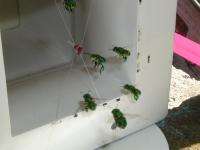Flying tip of bees: Leave your legs dangling!

Unlike airplanes, leaving their landing gear down makes bees fly faster. When orchid bees extend their hind-legs they pitch forward to achieve maximal speed, and the legs produce lift forces to either side that help prevent the bee from rolling.
"The hind-legs resemble airplane wings, which probably explains why they also generate lift", says Dr Stacey Combes from the University of California, Berkeley who will present her research on Tuesday 4th April at the Society for Experimental Biology's Annual Main Meeting in Canterbury, Kent.
This research is interesting as it could be applied to design miniature flying machines to be used for search and rescue missions. "It may be helpful to be able to reduce the number of control components needed by using one structure (like the orchid bee legs) to control both pitch and roll", speculates Dr Combes.
The researchers perform their experiments by encouraging the bees to fly in an outdoor wind tunnel using an incentive of aromatic oils. The bees can reach a maximum speed of 7.25 m/s, but at these speeds they lose rotational stability: "They roll all the way to the side or often upside down, and crash to the ground", observes Combes. This means that what limits the bee's speed is not muscle power or the amplitude of its wing beat, but the pitch of the body balanced with the resulting rotational instability. "Having the legs extended generates stabilizing lift forces and helps reduce the moment of inertia and the slow rolling, similar to when a spinning figure-skater extends their arms", explains Combes.
Source: Society for Experimental Biology


















